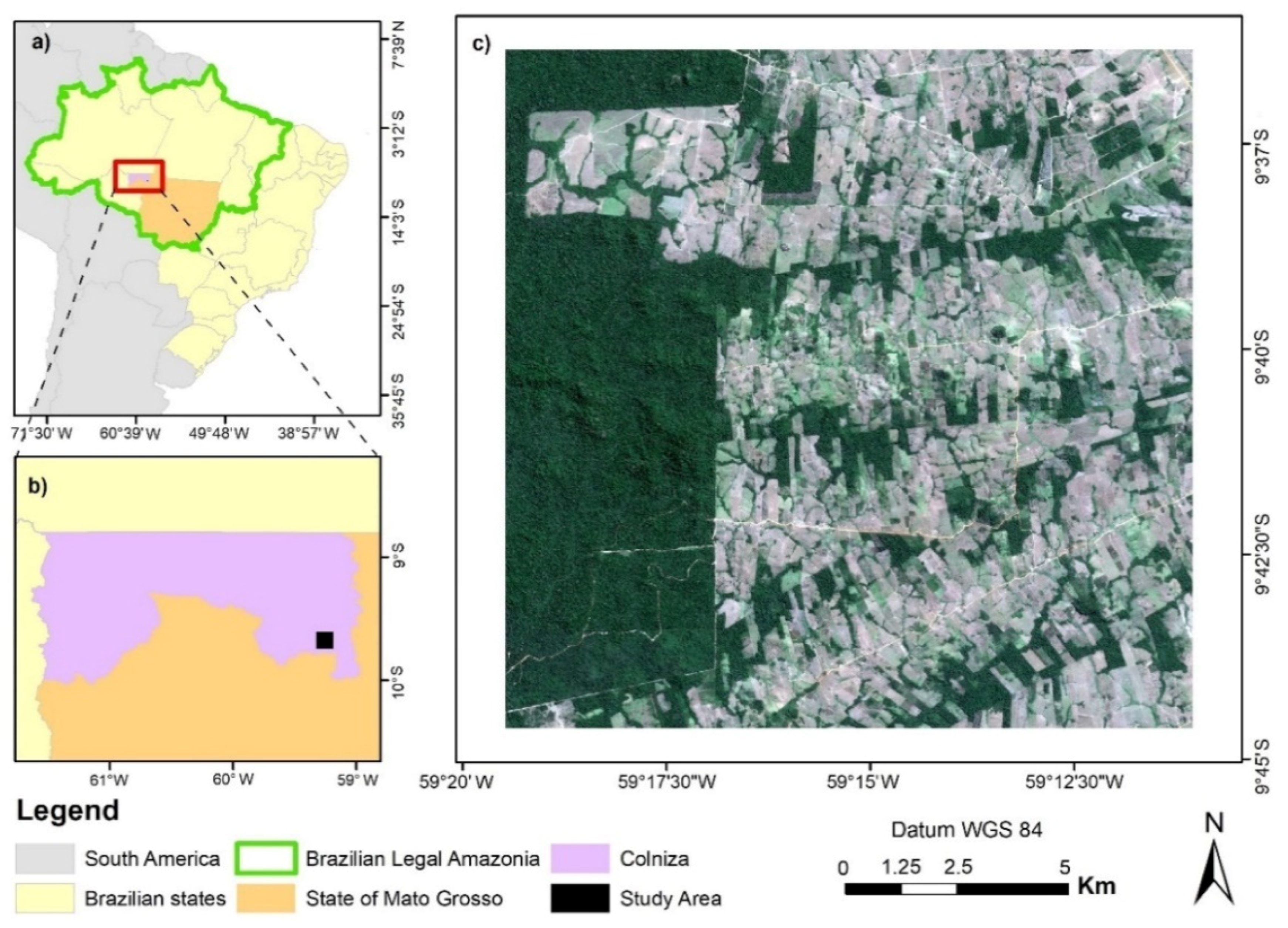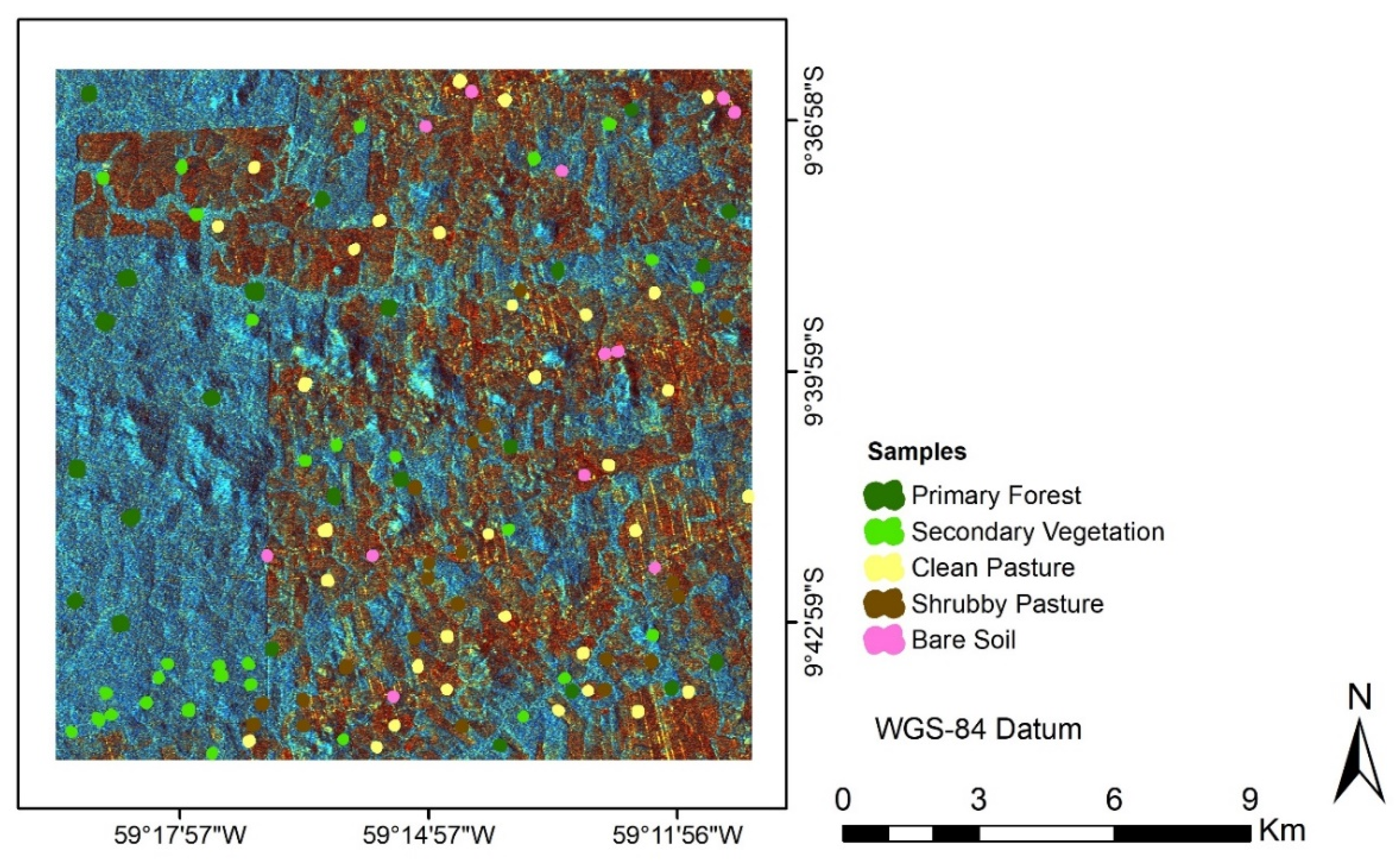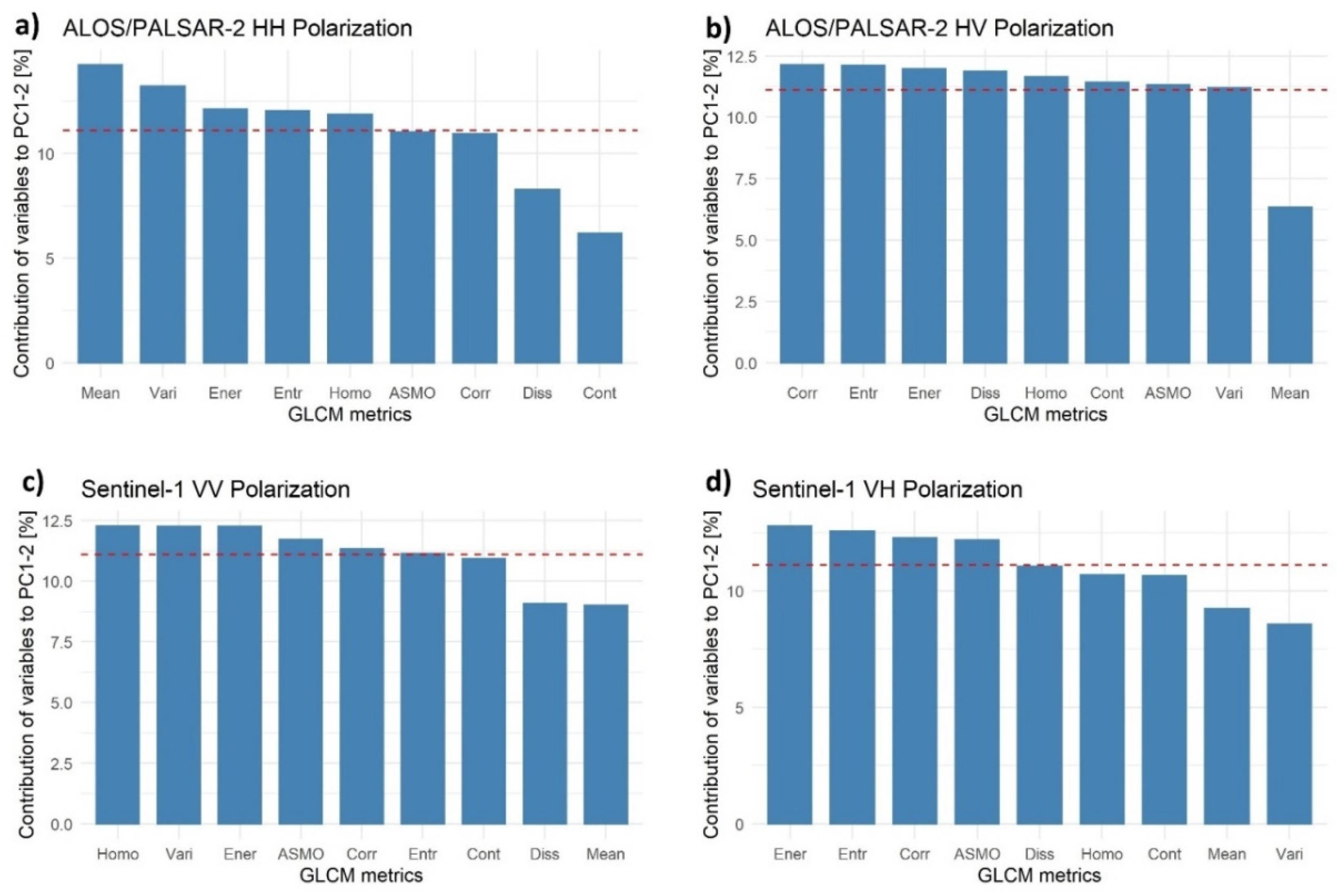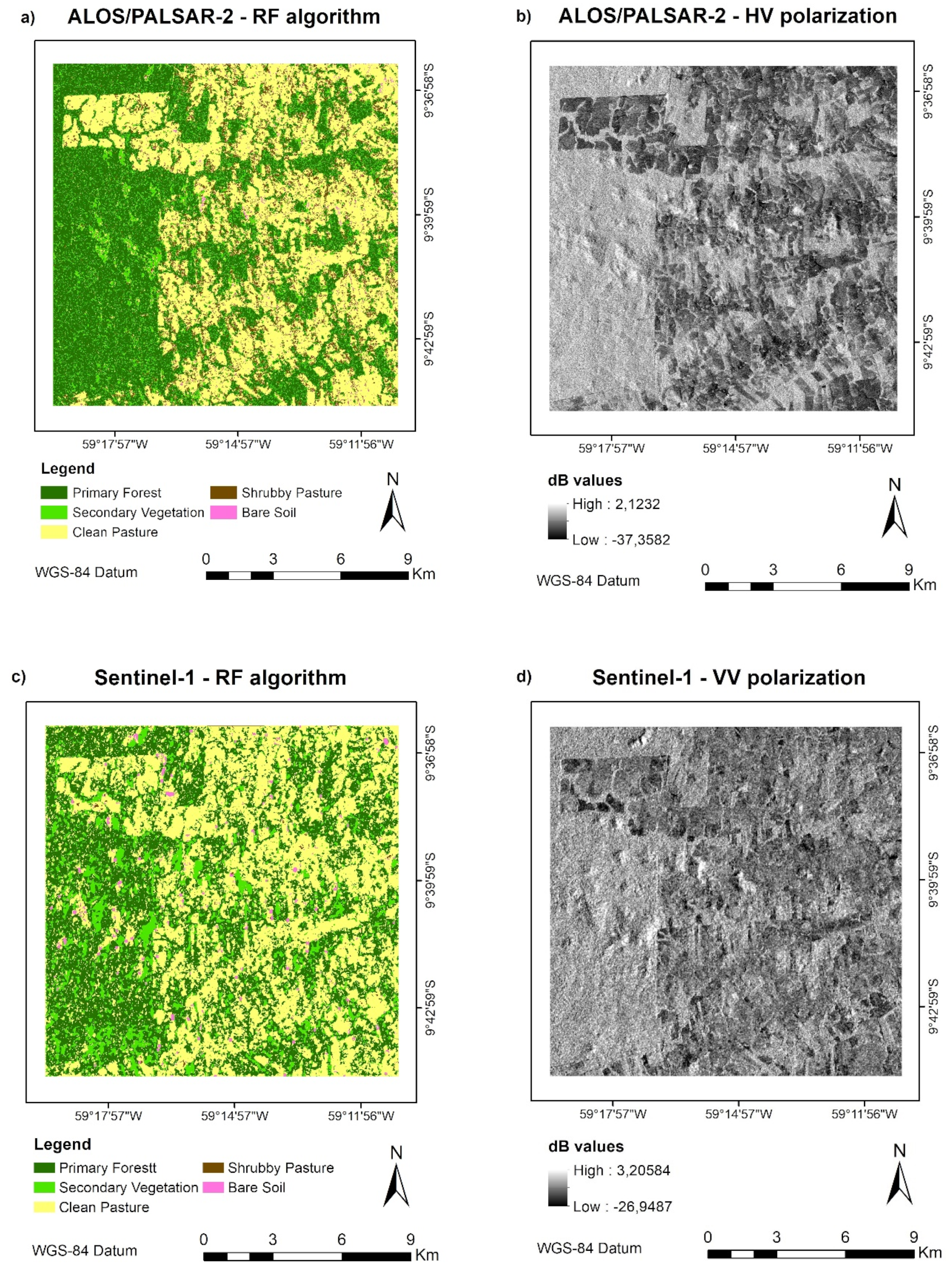Mapping Secondary Vegetation of a Region of Deforestation Hotspot in the Brazilian Amazon: Performance Analysis of C- and L-Band SAR Data Acquired in the Rainy Season
Abstract
:1. Introduction
2. Materials and Methods
2.1. Study Area
2.2. Satellite Images
2.3. Methods
2.3.1. Pre-Processing
2.3.2. Feature Selection
2.3.3. Principal Component Analysis
2.3.4. Reference Data and Sample Selection
- Primary Forest (PF): areas of upland, broadleaf rainfall forests and gallery forests along drainages with no evidence of human activities;
- Secondary Vegetation (SV): clear-cut forests that are regrowing as consequence of abandonment (see more details in the Introduction section);
- Clean Pasture (CP): well-managed pastures for beef production;
- Shrubby Pasture (SP): poorly managed pastures for beef production, with the presence of weeds; and
- Bare Soil (BS): relatively small areas without vegetation cover, mostly along the roads.
2.3.5. Machine Learning Classifications
2.3.6. Accuracy Analysis
3. Results
3.1. C- and L-Band Backscatter Coefficients
3.2. Most Relevant Texture Attributes of SAR Images
3.3. Random Forest and Support Vector Machine Classification Results for the SAR Data
4. Discussion
5. Conclusions
Author Contributions
Funding
Data Availability Statement
Acknowledgments
Conflicts of Interest
References
- INPE. TerraBrasilis. PRODES (Deforestation). 2022. Available online: http://terrabrasilis.dpi.inpe.br/app/dashboard/deforestation/biomes/legal_amazon/rates (accessed on 24 June 2022).
- Sauer, S. Soy expansion into the agricultural frontiers of the Brazilian Amazon: The agribusiness economy and its social and environmental conflits. Land Use Policy 2018, 79, 326–338. [Google Scholar] [CrossRef]
- Miranda, J.; Börner, J.; Kalkuhl, M.; Soares-Filho, B. Land speculation and conservation policy leakage in Brazil. Environ. Res. Lett. 2019, 14, 045006. [Google Scholar] [CrossRef]
- Arias, M.E.; Farinosi, F.; Lee, E.; Livino, A.; Briscoe, J.; Moorcroft, P.R. Impacts of climate change and deforestation on hydropower planning in the Brazilian Amazon. Nat. Sustain. 2020, 3, 430–436. [Google Scholar] [CrossRef]
- Skidmore, M.E.; Moffette, F.; Rausch, L.; Christie, M.; Munger, J.; Gibbs, H.K. Cattle ranchers and deforestation in the Brazilian Amazon: Production, location, and policies. Global Environ. Chang. 2021, 68, 102280. [Google Scholar] [CrossRef]
- Pereira, E.J.A.L.; Ferreira, P.J.S.; Ribeiro, L.C.S.; Carvalho, T.S.; Pereira, H.B.B. Policy in Brazil (2016–2019) threaten conservation of the Amazon rainforest. Environ. Sci. Policy 2019, 100, 8–12. [Google Scholar] [CrossRef]
- Trancoso, R. Changing Amazon deforestation patterns: Urgent need to restore command and control policies and market interventions. Environ. Res. Lett. 2021, 16, 041004. [Google Scholar] [CrossRef]
- Corlett, R.T. What is secondary forest? J. Trop. Ecol. 1994, 10, 445–447. [Google Scholar] [CrossRef]
- CDB. Definitions: Indicative Definitions Taken from the Report of the Ad Hoc Technical Expert Group on Forest Biological Diversity. 2006. Available online: https://www.cbd.int/forest/definitions.shtml (accessed on 24 June 2022).
- FAO. Global Forest Resources Assessment 2020; Main Report; FAO: Rome, Italy, 2020; 186p. [Google Scholar]
- Almeida, C.A.; Coutinho, A.C.; Esquerdo, J.C.D.M.; Adami, M.; Venturieri, A.; Diniz, C.G.; Dessay, N.; Durieux, L.; Gomes, A.R. High spatial resolution land use and land cover mapping of the Brazilian Legal Amazon in 2008 using Landsat-5/TM and MODIS data. Acta Amazon. 2016, 46, 291–302. [Google Scholar] [CrossRef]
- INPE. TerraClass. Projetos e Pesquisas. 2019a. Available online: http://www.inpe.br/cra/projetos_pesquisas/dados_terraclass.php (accessed on 24 June 2022).
- Chazdon, R.L.; Broadbent, E.N.; Rozendaal, D.M.; Bongers, F.; Zambrano, A.M.A.; Aide, T.M.; Balvanera, P.; Becknell, J.M.; Boukili, V.; Bracalion, P.H.S.; et al. Carbon sequestration potential of second-growth forest regeneration in the Latin American tropics. Sci. Adv. 2016, 2, e1501639. [Google Scholar] [CrossRef]
- Bongers, F.; Chazdon, R.; Poorter, L.; Peña-Claros, M. The potential of secondary forests. Science 2015, 348, 642–643. [Google Scholar] [CrossRef]
- Strassburg, B.B.N.; Latawiec, A.E.; Barioni, L.G.; Nobre, C.A.; Silva, V.P.; Valentim, J.F.; Vianna, M.; Assa, E.D. When enough should be enough: Improving the use of current agricultural lands could meet production demands and spare natural habitats in Brazil. Glob. Environ. Change 2014, 28, 84–97. [Google Scholar] [CrossRef]
- Klemick, H. Shifting cultivation, forest fallow, and externalities in ecosystem services: Evidence from the Eastern Amazon. J. Environ. Econ. Manag. 2011, 61, 95–106. [Google Scholar] [CrossRef]
- Nunes, S.; Oliveira, L., Jr.; Siqueira, J.; Morton, D.C.; Souza, C.M., Jr. Unmasking secondary vegetation dynamics in the Brazilian Amazon. Environ. Res. Lett. 2020, 15, 034057. [Google Scholar] [CrossRef]
- Soares-Filho, B.; Rajão, R.; Macedo, M.; Carneiro, A.; Costa, W.; Coe, M.; Rodrigues, H.; Alencar, A. Cracking Brazil’s forest code. Science 2014, 344, 363–364. [Google Scholar] [CrossRef]
- Diniz, C.G.; Souza, A.A.A.; Santos, D.C.; Dias, M.C.; Luz, N.C.; Moraes, R.V.; Maia, J.S.; Gomes, A.R.; Narvaes, I.S.; Valeriano, D.M.; et al. DETER-B: The new Amazon near real-time deforestation detection system. IEEE J. Sel. Top. Appl. Earth Obs. Remote Sens. 2015, 8, 3619–3628. [Google Scholar] [CrossRef]
- IMAZON. Sistema De Alerta De Desmatamento (Sad)—Maio De 2022. Available online: https://imazon.org.br/publicacoes/sistema-de-alerta-de-desmatamento-sad-maio-de-2022/ (accessed on 24 June 2022).
- Souza, C.M., Jr.; Shimbo, J.Z.; Rosa, M.R.; Parente, L.L.; Alencar, A.A.; Ruddorff, B.F.T.; Hasenack, H.; Matsumoto, M.; Ferreira, L.G.; Souza-Filho, P.W.M.; et al. Reconstructing three decades of land use and land cover changes in Brazilian biomes with Landsat archive and Earth Engine. Remote Sens. 2020, 12, 2735. [Google Scholar] [CrossRef]
- Lucas, R.M.; Xiao, X.; Hagen, S.; Frolking, S. Evaluating TERRA-1 MODIS data for discrimination of tropical secondary forest regeneration stages in the Brazilian Legal Amazon. Geophys. Res. Lett. 2002, 29, 1–4. [Google Scholar] [CrossRef]
- Asner, G.P.; Rudel, T.K.; Aide, T.M.; Defries, R.; Emerson, R. A Contemporary assessment of change in humid tropical forests. Conserv. Biol. 2009, 23, 1386–1395. [Google Scholar] [CrossRef]
- Wang, J.; Yang, D.; Detto, M.; Nelson, B.W.; Chen, M.; Guan, K.; Wu, S.; Yan, Z.; Wu, J. Multi-scale integration of satellite remote sensing improves characterization of dry-season green-up in an Amazon tropical evergreen forest. Remote Sens. Environ. 2020, 246, 111865. [Google Scholar] [CrossRef]
- Vieira, I.C.G.; Gardner, T.; Ferreira, J.; Lees, A.C.; Barlow, J. Challenges of governing second-growth forests: A case study from the Brazilian Amazonian State of Pará. Forests 2014, 5, 1737–1752. [Google Scholar] [CrossRef] [Green Version]
- Shimada, M.; Isoguchi, O.; Tadono, T.; Isono, K. PALSAR radiometric and geometric calibration. IEEE Trans. Geosci. Remote Sens. 2009, 47, 3915–3932. [Google Scholar] [CrossRef]
- Watanabe, M.; Koyama, C.; Hayashi, M.; Nagatani, I.; Shimada, M. Early-stage deforestation detection in the tropics with L-band SAR. IEEE J. Sel. Top. Appl. Earth Obs. Remote Sens. 2018, 11, 1–7. [Google Scholar] [CrossRef]
- Watanabe, M.; Koyama, C.; Hayashi, M.; Nagatani, I.; Tadono, T.; Shimada, M. Refined algorithm for forest early warning system with ALOS-2/PALSAR-2 ScanSAR data in tropical forest regions. Remote Sens. Environ. 2021, 265, 112643. [Google Scholar] [CrossRef]
- Cassol, H.L.G.; Aragão, L.E.O.C.; Moraes, E.C.; Carriras, J.M.B.; Shimabukuro, Y.E. Quad-pol advanced land observing satellite/phased array L-band synthetic aperture radar-2 (ALOS/PALSAR-2) data for modeling secondary forest above-ground biomass in the central Brazilian Amazon. Int. J. Remote Sens. 2021, 42, 4985–5009. [Google Scholar] [CrossRef]
- Leckie, D.G.; Ranson, K.J. Forestry applications using imaging SAR. In Principles and Application of Imaging Radar. Manual of Remote Sensing, 3rd ed.; Henderson, F.M., Lewis, A.J., Eds.; John Wiley & Sons: Hoboken, NJ, USA, 1998. [Google Scholar]
- Torres, R.; Snoeij, P.; Geudtner, D.; Bibby, D.; Davidson, M.; Attema, E.; Potin, P.; Rommen, B.; Floury, N.; Brown, M.; et al. GMES Sentinel-1 mission. Remote Sens. Environ. 2012, 120, 9–24. [Google Scholar] [CrossRef]
- Doblas, J.; Shimabukuro, Y.; Sant´Anna, S.; Carneiro, A.; Aragão, L.; Almeida, C. Optimizing near real-time detection of deforestation on tropical rainforests using Sentinel-1 data. Remote Sens. 2020, 12, 3922. [Google Scholar] [CrossRef]
- Hoekmann, D.; Kooij, B.; Quiñones, M.; Vellekoop, S.; Carolita, I.; Budhiman, S.; Arief, R.; Roswintiarti, O. Wide-area near-real-time monitoring of tropical forest degradation and deforestation using Sentinel-1. Remote Sens. 2020, 12, 3263. [Google Scholar] [CrossRef]
- Silva, C.A.; Guerrisi, G.; Del Frate, F.; Sano, E.E. Near-real time deforestation detection in the Brazilian Amazon with Sentinel-1 and neural networks. Eur. J. Remote Sens. 2022, 55, 129–149. [Google Scholar] [CrossRef]
- Kuplich, T.M. Classifying regenerating forest stages in Amazônia using remotely sensed images and a neural network. For. Ecol. Manage. 2006, 234, 1–9. [Google Scholar] [CrossRef]
- Carreiras, J.M.B.; Jones, J.; Lucas, R.M.; Shimabukuro, Y.E. Mapping major land cover types and retrieving the age of secondary forests in the Brazilian Amazon by combining single-date optical and radar remote sensing data. Rem. Sens. Environ. 2017, 194, 16–32. [Google Scholar] [CrossRef] [Green Version]
- Doblas, J.; Reis, M.S.; Belluzzo, A.P.; Quadros, C.B.; Moraes, D.R.V.; Almeida, C.A.; Maurano, L.E.P.; Carvalho, A.F.A.; Sant´Anna, S.J.S.; Shimabukuro, Y.E. DETER-R: An operational near-real time tropical forest disturbance warning system based on Sentinel-1 time series analysis. Remote Sens. 2022, 14, 3658. [Google Scholar] [CrossRef]
- Assunção, J.J.; Gandour, C. What Does the Surge in Amazon Regeneration Mean for Brazil? Climate Policy Initiative: Rio de Janeiro, Brazil, 2017; Available online: https://climatepolicyinitiative.org/publication/surge-amazon-regeneration-mean-brazil/ (accessed on 22 August 2018).
- Aoki, Y.; Furuya, M.; Zan, F.; Doin, M.P.; Eineder, M.; Ohki, M.; Wright, T.J. L-band synthetic aperture radar: Current and future applications to Earth sciences. Earth Planets Space 2021, 73, 56. [Google Scholar] [CrossRef]
- IBGE. Manual Técnico da Vegetação Brasileira. Manuais Técnicos em Geociências, n. 1; IBGE: Rio de Janeiro, Brazil, 2012; 274p. [Google Scholar]
- Santos, M.V. Zoneamento sócio-econômico-ecológico: Diagnóstico sócio-econômico-ecológico do Estado de Mato Grosso e assistência técnica na formulação da 2ª aproximação; SEPLAN-MT: Cuiabá, MT, Brazil, 2000. [Google Scholar]
- MapBiomas. MapBiomas v. 6.0. Available online: https://mapbiomas.org/en/statistics (accessed on 25 June 2022).
- Halbgewachs, M.; Wegmann, M.; Ponte, E. A spectral mixture analysis and landscape metrics based framework for monitoring spatiotemporal forest cover changes: A case study in Mato Grosso, Brazil. Remote Sens. 2022, 14, 1907. [Google Scholar] [CrossRef]
- Drusch, M.; Bello, U.D.; Carlier, S.; Colin, O.; Fernandez, V.; Gascon, F.; Hoersch, B.; Isola, C.; Laberinti, P.; Martimort, P.; et al. Sentinel-2: ESA´s optical high-resolution mission for GMES operational services. Remote Sens. Environ. 2012, 120, 25–36. [Google Scholar] [CrossRef]
- INPE. CBERS 04A. 2019. Available online: http://www.cbers.inpe.br/sobre/cbers04a.php?_ga=2.99883486.151721476.1656282945-118845307.1656282944 (accessed on 26 June 2022).
- JAXA. Calibration Results of ALOS-2/PALSAR-2 JAXA Standard Products. Available online: https://www.eorc.jaxa.jp/ALOS-2/en/calval/calval_index.htm (accessed on 8 February 2022).
- Small, D. Flattening Gamma: Radiometric terrain correction for SAR imagery. IEEE Trans. Geosci. Remote Sens. 2011, 49, 3081–3093. [Google Scholar] [CrossRef]
- Hagensieker, R.; Waske, B. Evaluation of multi-frequency SAR images for tropical land cover mapping. Remote Sens. 2018, 10, 257. [Google Scholar] [CrossRef]
- Haralick, R.M.; Shanmugam, K.; Dinstein, I.H. Textural features for image classification. IEEE Trans. Syst. Man Cybern. Syst. 1973, 3, 610–621. [Google Scholar] [CrossRef]
- Kurvonen, L.; Hallikainen, M.T. Textural information of multitemporal ERS-1 and JERS-1 SAR images with applications to land and forest type classification in boreal zone. IEEE Tran. Geosci. Remote Sens. 1999, 37, 680–689. [Google Scholar] [CrossRef]
- Baraldi, A.; Parmiggiani, F. A refined gamma MAP SAR speckle filter with improved geometrical adaptivity. IEEE Trans. Geosci. Remote Sens. 1995, 33, 1245–1257. [Google Scholar] [CrossRef]
- Lu, D.; Batistella, M. Exploring TM image texture and its relationships with biomass estimation in Rondônia, Brazilian Amazon. Acta Amaz. 2005, 35, 249–257. [Google Scholar] [CrossRef]
- Sothe, C.; Almeida, C.M.; Liesenberg, V.; Schimalski, M.B. Evaluating Sentinel-2 and Landsat-8 data to map successional forest stages in a subtropical forest in southern Brazil. Remote Sens. 2017, 9, 838. [Google Scholar] [CrossRef]
- Zakeri, H.; Yamazaki, F.; Liu, W. Texture analysis and land cover classification of Tehran using polarimetric synthetic aperture radar imagery. Appl. Sci. 2017, 7, 452. [Google Scholar] [CrossRef]
- Azevedo, A.R.D.; Santos, J.R.D.; Gama, F.F.; Graça, P.M.L.D.A.; Mura, J.C. Caracterização de uso e cobertura da terra na Amazônia utilizando imagens duais multitemporais do COSMO-SkyMed. Acta Amaz. 2014, 44, 87–97. [Google Scholar] [CrossRef]
- Jolliffe, I.T. Principal Component Analysis; Springer: New York, NY, USA, 2002. [Google Scholar]
- Wiederkehr, N.C.; Gama, F.F.; Castro, P.B.; Bispo, P.D.C.; Balzter, H.; Sano, E.E.; Mura, J.C. Discriminating Forest successional stages, forest degradation, and land use in central amazon using ALOS/PALSAR-2 full-polarimetric data. Remote Sens. 2020, 12, 3512. [Google Scholar] [CrossRef]
- Soares, J.V.; Rennó, C.D.; Formaggio, A.R.; Yanasse, C.C.F.; Frery, A.C. An investigation of the selection of texture features for crop discrimination using SAR imagery. Remote Sens. Environ. 1997, 59, 234–247. [Google Scholar] [CrossRef]
- Stehman, S.V. Impact of sample size allocation when using stratified random sampling to estimate accuracy and area of land-cover change. Remote Sens. Lett. 2012, 3, 111–120. [Google Scholar] [CrossRef]
- Olofsson, P.; Foody, G.M.; Herold, M.; Stehman, S.V.; Woodcock, C.E.; Wulder, M.A. Good practices for estimating area and assessing accuracy of land change. Remote Sens. Environ. 2014, 148, 42–57. [Google Scholar] [CrossRef]
- Van der Linden, S.; Rabe, A.; Held, M.; Jakimow, B.; Leitão, P.J.; Okujeni, A.; Schwieder, S.S.; Hostert, P. The EnMAP-Box—A toolbox and application programming interface for EnMAP data processing. Remote Sens. 2015, 7, 11249–11266. [Google Scholar] [CrossRef]
- Diniz, J.M.F.S.; Gama, F.F.; Adami, M. Evaluation of polarimetry and interferometry of Sentinel-1A SAR data for land use and land cover of the Brazilian Amazon region. Geocarto Int. 2022, 37, 1482–1500. [Google Scholar] [CrossRef]
- Breiman, L. Random Forests. Mach. Learn. 2001, 45, 5–32. [Google Scholar] [CrossRef] [Green Version]
- Belgiu, M.; Drăguţ, L. Random forest in remote sensing: A review of applications and future directions. ISPRS J. Photogramm. Remote Sens. 2016, 114, 24–31. [Google Scholar] [CrossRef]
- Sheykhmousa, M.; Mahdianpari, M.; Ghanbari, H.; Mohammadimanesh, F.; Ghamisi, P.; Homayouni, S. Support vector machine versus random forest for remote sensing image classification: A meta-analysis and systematic review. IEEE J. Sel. Top. Appl. Earth Obs. Remote Sens. 2020, 13, 6308–6325. [Google Scholar] [CrossRef]
- Petropoulos, G.P.; Kontoes, C.; Keramitsoglou, I. Burnt area delineation from a uni-temporal perspective based on Landsat TM imagery classification using Support Vector Machines. Int. J. Appl. Earth Obs. Geoinf. 2011, 13, 70–80. [Google Scholar] [CrossRef]
- Karatzoglou, A.; Meyer, D.; Hornik, K. Support vector machines in R. J. Stat. Softw. 2006, 15, 1–28. [Google Scholar] [CrossRef]
- Huang, C.; Davis, L.S.; Townshend, J.R.G. An assessment of support vector machines for land cover classification. Int. J. Remote Sens. 2002, 23, 725–749. [Google Scholar] [CrossRef]
- Van der Linden, S.; Rabe, A.; Held, M.; Wirth, F.; Suess, S.; Okujeni, A.; Hostert, P. Image SVM Classification. Manual for Application: Image SVM Version 3.0; Humboldt-Universität: Berlin, Germany, 2014. [Google Scholar]
- Lewis, A.J.; Henderson, F.M. Radar fundamentals: The geosciences perspective. In Principles and Applications of Imaging Radar. Manual of Remote Sensing, 3rd ed.; Henderson, F.M., Lewis, A.J., Eds.; John Wiley & Sons: Hoboken, NJ, USA, 1998; pp. 131–181. [Google Scholar]
- Silva, V.S.; Sano, E.E.; Almeida, T.; Mesquita Júnior, H.N. Discriminating vegetation cover classes of an Amazon/Cerrado transition region in the Mato Grosso State using ALOS-2/PALSAR-2 satellite images. Rev. Bras. Cartogr. 2021, 73, 1–16. [Google Scholar] [CrossRef]
- Aboud Neta, S.R. Uso De Imagens ALOS/PALSAR Multipolarizadas Para Detecção De Incremento De Desflorestamento Na Amazônia. M.Sc. thesis, National Institute for Space Research, São José, dos Campos, SP, Brazil, 30 September 2009. [Google Scholar]
- Li, G.; Lu, D.; Moran, E.; Dutra, L.; Batistella, M. A comparative analysis of ALOS PALSAR L-band and RADARSAT-2 C-band data for land-cover classification in a tropical moist region. ISPRS J. Photogramm. Remote Sens. 2012, 70, 26–38. [Google Scholar] [CrossRef]
- Mercier, A.; Betbeder, J.; Rumiano, F.; Baudry, J.; Gond, V.; Blanc, L.; Bourgoin, C.; Cornu, G.; Ciudad, C.; Marchamalo, M.; et al. Evaluation of Sentinel-1 and 2 time series for land cover classification of forest-agriculture mosaics in temperate and tropical landscapes. Remote Sens. 2019, 11, 979. [Google Scholar] [CrossRef]
- Nicolau, A.P.; Flores-Anderson, A.; Griffin, R.; Herndon, K.; Meyer, F.J. Assessing SAR C-band data to effectively distinguish modified land uses in a heavily disturbed Amazon Forest. Int. J. Appl. Earth Obs. Geoinf. 2021, 94, 102214. [Google Scholar] [CrossRef]
- Zhou, J.; Guo, R.Y.; Sun, M.; Di, T.T.; Wang, S.; Zhai, J.; Zhao, Z. The effects of GLCM parameters on LAI estimation using texture values from Quickbird satellite imagery. Sci. Rep. 2017, 7, 7366. [Google Scholar] [CrossRef] [Green Version]
- Coburn, C.A.; Roberts, A.C.B. A multiscale texture analysis procedure for improved forest stand classification. Int. J. Remote Sens. 2004, 25, 4287–4308. [Google Scholar] [CrossRef]
- Zhu, Z.; Woodcock, C.E.; Rogan, J.; Kellndorfer, J. Assessment of spectral, polarimetric, temporal, and spatial dimensions for uban and peri-urban land cover classification using Landsat and SAR data. Remote Sens. Environ. 2012, 117, 72–82. [Google Scholar] [CrossRef]
- Pavanelli, J.A.P.; Santos, J.R.; Galvão, L.S.; Xaud, M.R.; Xaud, H.A.M. PALSAR-2/ALOS-2 and OLI/Landsat-8 data integration for land use and land cover mapping in northern Brazilian Amazon. Bull. Geod. Sci. 2018, 24, 250–269. [Google Scholar] [CrossRef]
- Pelletier, C.; Valero, S.; Inglada, J.; Champion, N.; Marais Sicre, C.; Dedieu, G. Effect of training class label noise on classification performances for land cover mapping with satellite image time series. Remote Sens. 2017, 9, 173. [Google Scholar] [CrossRef] [Green Version]








| Sensor | Experiment | Data Composition | GLCM Window Size |
|---|---|---|---|
| ALOS/PALSAR-2 | A1 | HH + HV | - |
| A2 | HH + HV + GLCMPC1 + GLCMPC2 | 5 × 5 | |
| A3 | HH + HV + GLCMPC1 + GLCMPC2 | 7 × 7 | |
| A4 | HH + HV + GLCMPC1 + GLCMPC2 | 9 × 9 | |
| A5 | HH + HV + GLCMPC1 + GLCMPC2 | 11 × 11 | |
| Sentinel-1 | S1 | VV + VH | - |
| S2 | VV + VH + GLCMPC1 + GLCMPC2 | 5 × 5 | |
| S3 | VV + VH + GLCMPC1 + GLCMPC2 | 7 × 7 | |
| S4 | VV + VH + GLCMPC1 + GLCMPC2 | 9 × 9 | |
| S5 | VV + VH + GLCMPC1 + GLCMPC2 | 11 × 11 |
| Satellite | Experiments | Data Composition | No. Images |
|---|---|---|---|
| ALOS/ PALSAR-2 | A1 | L-HH + L-HV | 2 |
| A2, A3, A4, and A5 | L-HH + L-HH(mean) + L-HH(vari) + L-HH(ener) + L-HH(entr) + L-HH(homo) + L-HV + L-HV(corr) +L-HV(entr) + L-HV(ener) + L-HV(diss) + L-HV(homo) + L-HV(contr) + L-HV(ASMO) + L-HV(vari) | 15 | |
| Sentinel-1 | S1 | C-VV + C-VH | 2 |
| S2, S3, S4, and S5 | C-VV + C-VV(homo) + C-VV(vari) + C-VV(ener) + C-VV(ASMO) + C-VV(corr) + C-VH + C-VH(ener) + C-VH(entr) + C-VH(corr) + C-VH(ASMO) | 11 |
| Experiment | User’s Accuracy (%) | Producer’s Accuracy (%) | OA % | Kappa | ||||||||
|---|---|---|---|---|---|---|---|---|---|---|---|---|
| PF | SV | CP | SP | BS | PF | SV | CP | SP | BS | |||
| A1 | 67.52 | 59.87 | 75.52 | 52.99 | 40.00 | 81.00 | 44.29 | 86.55 | 32.05 | 8.60 | 67.75 | 0.54 |
| A2 | 70.79 | 72.44 | 74.72 | 63.70 | 75.00 | 90.50 | 43.59 | 94.59 | 20.99 | 3.23 | 72.16 | 0.60 |
| A3 | 74.58 | 73.43 | 80.74 | 74.68 | 60.00 | 91.58 | 53.53 | 92.53 | 39.95 | 9.68 | 76.29 | 0.66 |
| A4 | 77.50 | 77.87 | 84.60 | 76.31 | 70.59 | 91.94 | 58.69 | 93.77 | 55.98 | 12.90 | 79.62 | 0.71 |
| A5 | 82.60 | 84.52 | 86.63 | 82.64 | 91.67 | 95.15 | 68.32 | 95.16 | 67.72 | 11.83 | 84.20 | 0.78 |
| S1 | 59.11 | 62.18 | 65.74 | 57.69 | 28.57 | 72.28 | 53.33 | 72.52 | 27.03 | 8.00 | 61.35 | 0.45 |
| S2 | 57.45 | 66.22 | 58.36 | 72.41 | 80.00 | 72.28 | 43.56 | 75.95 | 18.92 | 32.00 | 59.74 | 0.42 |
| S3 | 64.62 | 80.72 | 67.35 | 75.56 | 71.43 | 82.88 | 59.56 | 75.57 | 30.63 | 40.00 | 68.72 | 0.55 |
| S4 | 66.60 | 78.28 | 79.07 | 73.58 | 91.67 | 85.05 | 68.89 | 77. 86 | 35.14 | 44.00 | 72.86 | 0.61 |
| S5 | 75.82 | 81.16 | 88.89 | 84.31 | 90.00 | 92.99 | 76.02 | 85.41 | 42.57 | 47.37 | 81.07 | 0.73 |
| Experiment | User’s Accuracy (%) | Producer’s Accuracy (%) | OA % | Kappa | ||||||||
|---|---|---|---|---|---|---|---|---|---|---|---|---|
| PF | SV | CP | SP | BS | PF | SV | CP | SP | BS | |||
| A1 | 47.40 | 65.33 | 53.24 | 0.00 | 0.00 | 74.18 | 21.78 | 69.08 | 2.26 | 0.00 | 50.76 | 0.27 |
| A2 | 50.17 | 66.33 | 58.42 | 50.00 | 83.33 | 78.53 | 28.89 | 67.56 | 0.90 | 40.00 | 54.69 | 0.33 |
| A3 | 55.41 | 70.59 | 66.42 | 69.57 | 84.62 | 82.07 | 42.67 | 69.47 | 14.41 | 44.00 | 61.25 | 0.44 |
| A4 | 65.50 | 75.66 | 71.89 | 63.46 | 81.82 | 81.52 | 63.56 | 77.10 | 29.73 | 36.00 | 69.32 | 0.56 |
| A5 | 70.32 | 72.20 | 86.33 | 65.57 | 100.00 | 83.02 | 66.97 | 85.41 | 39.60 | 57.89 | 75.23 | 0.65 |
| S1 | 45.92 | 53.12 | 53.25 | 0.00 | 100.00 | 60.16 | 35.06 | 75.08 | 0.00 | 1.04 | 49.89 | 0.28 |
| S2 | 48.82 | 56.80 | 54.79 | 0.00 | 57.14 | 66.45 | 38.82 | 71.52 | 0.00 | 12.50 | 52.31 | 0.32 |
| S3 | 50.03 | 60.80 | 57.00 | 0.00 | 42.50 | 69.58 | 42.71 | 69.58 | 0.00 | 17.71 | 54.04 | 0.34 |
| S4 | 52.47 | 57.66 | 60.02 | 0.00 | 38.89 | 72.03 | 46.47 | 70.09 | 0.00 | 14.58 | 55.73 | 0.37 |
| S5 | 56.79 | 59.89 | 64.83 | 10.00 | 36.54 | 70.60 | 53.06 | 80.26 | 0.25 | 19.79 | 59.74 | 0.43 |
Publisher’s Note: MDPI stays neutral with regard to jurisdictional claims in published maps and institutional affiliations. |
© 2022 by the authors. Licensee MDPI, Basel, Switzerland. This article is an open access article distributed under the terms and conditions of the Creative Commons Attribution (CC BY) license (https://creativecommons.org/licenses/by/4.0/).
Share and Cite
Kiyohara, B.H.; Sano, E.E. Mapping Secondary Vegetation of a Region of Deforestation Hotspot in the Brazilian Amazon: Performance Analysis of C- and L-Band SAR Data Acquired in the Rainy Season. Forests 2022, 13, 1457. https://doi.org/10.3390/f13091457
Kiyohara BH, Sano EE. Mapping Secondary Vegetation of a Region of Deforestation Hotspot in the Brazilian Amazon: Performance Analysis of C- and L-Band SAR Data Acquired in the Rainy Season. Forests. 2022; 13(9):1457. https://doi.org/10.3390/f13091457
Chicago/Turabian StyleKiyohara, Bárbara Hass, and Edson Eyji Sano. 2022. "Mapping Secondary Vegetation of a Region of Deforestation Hotspot in the Brazilian Amazon: Performance Analysis of C- and L-Band SAR Data Acquired in the Rainy Season" Forests 13, no. 9: 1457. https://doi.org/10.3390/f13091457







